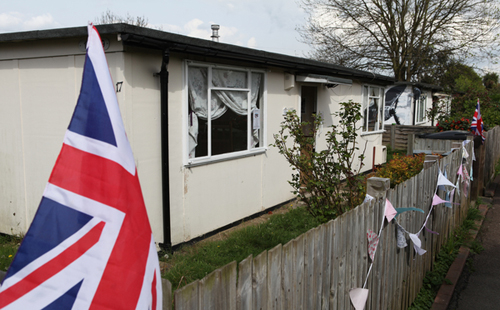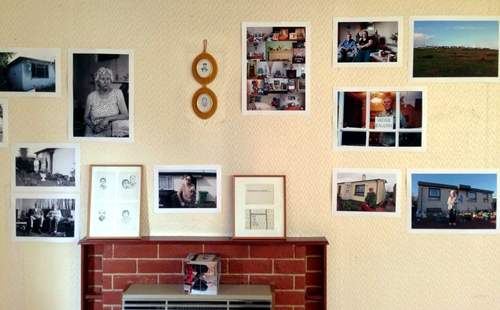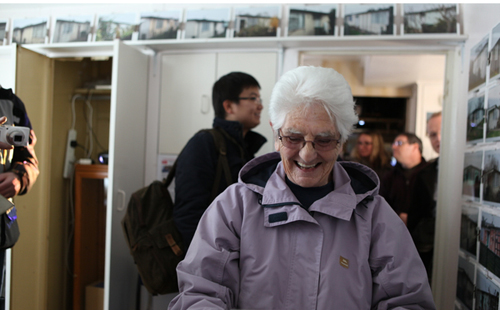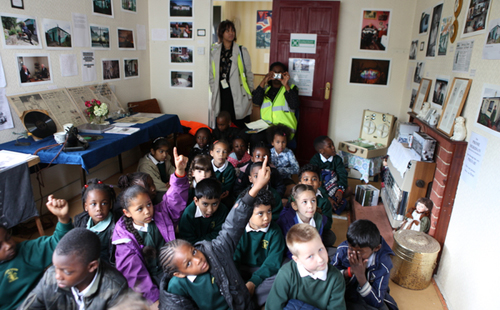Written by:
By Jane Hearn
The History of Prefabs in Lewisham
In 1935 The London County Council purchased farmland north of Whitefoot Lane from Lord Forster’s estate, for the purpose of construction of the North Downham estate, a community centre and doctor’s surgery. The prefab estate of 187 homes was constructed between 1945-7 on an open space of 15 acres adjoining the estate and nearby community centre. This open space had been requisitioned for allotments between 1940-5. Italian and German prisoners of war assisted with the construction.

The prefabs on the Excalibur Estate were produced by Uni-Seco Structures (Selection Engineering Company), mass producers of timber huts for the military in World War II. Mark 2 has a side entrance and Mark 3 a central entrance with canopy. Both types are of a modernist design, with wraparound windows. Prefabs were assembled with modern conveniences such as fitted kitchens with refrigerators, indoor bathroom and toilet, and built-in shelves and cupboards. They are detached on large plots with spacious gardens, and on a south/north axis.
The wonder of these ‘prefabs’ is that they were meant to last just 10 years to alleviate a post-war housing shortage but residents fell in love with them and have been fighting to make sure that they remain living in them. Prefabs have been described as the most successful example of social housing devised.

About the Prefab Museum
The Prefab Museum is located on the UK’s largest surviving prefab estate – in an empty prefab – in Lewisham. The museum is organised and curated by photographer Elisabeth Blanchet. Elisabeth has been photographing both residents and their prefab homes and collecting their stories for more than a decade, across the UK. The Prefab Museum is a unique living museum celebrating post-war prefab life through art and by sharing memories and archive.

This fascinating slice of 20th century social history, domestic life, hopes and dreams is a show case for artists’, photographers’ and film makers’ interpretations, memorabilia and artefacts. It is also a social and cultural space, where residents and visitors can meet, chat and have free refreshments.
Supported by the Arts Council, the Prefab Museum opened in March 2014 as a pop-up for one month. In its first two weeks, the museum attracted more than 700 visitors. To keep up with demand we extended the Prefab Museum residency until the end of May, and then until the end of September after the museum was accepted for Open House London. Unfunded since March the museum has been supported by volunteers, local residents and the donations of visitors. 2,500 visitors from all over London and the UK have made the journey to the museum at 17 Meliot Road since it opened.
The Prefab Museum is a unique experience where visitors stay longer than they have planned to, share ideas and stories, come out inspired and often come back!
The Prefab Museum has been granted an extension by Lewisham Council in its present home until at least 2017. We need to raise funds to support the museum until the beginning of 2015 while we await funding. Please pledge to our Kickstarter campaign if you can. There is a direct link to the campaign from The Prefab Museum website www.prefabmuseum.uk
All photos © Elisabeth Blanchet
Jane Hearn is a long-time local place champion and friend of The Glass-House, since we first supported Goldsmiths Community Centre in 2009, and more recently through the Creative Citizens project. Jane Hearn works in community development in South East London and is a volunteer with the Prefab Museum project.
